Choosing the right tubing is essential for pneumatic systems. It determines how fast circuit components (regulators, valves, and cylinders) operate. It also affects airflow and resistance to contaminants and the environment.
You can find a number of suppliers in Melbourne offering a wide range of tube materials and diameters. Some have a special inner profile that prevents kinking and ensures flow, even in applications with small bending radii.
It is easy to install
While electronic instruments have replaced pneumatic tube systems in many workplaces, the tubes themselves remain as useful and easy to install as ever. Their ease of handling, forming and joining permit savings in installation time, materials and overall costs. They also offer excellent long-term performance and reliability.
Pneumatic tubing has multiple uses, including bank drive-thrus where people exchange cash and checks with tellers (and sometimes a lollipop). Other businesses use these systems to transport documents, food or supplies between departments in large buildings. In hospitals, they deliver medical specimens and test results to labs for processing and storage.
Choosing the correct tubing size is important for optimal air flow in your system. Make sure that the outside diameter matches the size of your valves and cylinders. Using the right tubing can reduce pressure drop and prevent equipment breakdowns. Plastic push-to-connect fittings are available to improve integration and allow users to quickly change hoses or tools. They come in a variety of sizes, colors and materials. Some are even UV-stabilized for outdoor use.
It is durable
While the piping that carries critical air and fluids through automated equipment is less visible than the machine itself, it is just as important. This tubing must be durable enough to resist corrosion and other environmental factors. This is especially true in areas that require absolute cleanliness, like food processing or pharmaceutical production.
Tubing comes in a variety of materials and sizes, including elastomers, metals, and plastics. The material and working pressure requirements dictate tubing design. For example, tubing made from ether-based polyurethane resists attack from moisture and has a very high flex life. This makes it a good choice for industrial automation applications.
Flexible tubing is the most common way to connect pneumatic valves to cylinders, actuators, and vacuum generators in modern automated equipment. The most common tubing type is clear or black, but custom colors are available. Color-coding is helpful, and many systems use different colors for different lines, making it easy to distinguish between them.
It is easy to repair
Pneumatic tubing is essential for pneumatic systems, piping compressed air from the compressor to tools and machinery. It is available in a variety of materials, including polyurethane, nylon, and polyethylene. There are also a number of push-to-connect fittings, making it easy to select the right tubing for your system.
While the pneumatic tube may seem like a thing of the past, it's still used today to send mail and even medicines around hospitals. You may not see them much as truck delivery services improved, but they are still around at larger hospitals to speed up inter-office communications and transport lab specimens to doctors.
The most common type of tubing for pneumatic systems is flexible tubing. This type of tubing is easy to recoil, field repairable and kink-resistant. It is also safe for use in a wide range of temperatures, from -10 to 150 °F. It is a popular choice for a variety of applications, including food and beverage, steam, compressor discharge, and automotive.
It is easy to clean
Pneumatic tubing is easy to clean and requires little maintenance. Its design consists of simple materials such as plastics, zinc, and aluminum. It also uses pressurized air, which is a cheap and abundant source of power. The system is also extremely easy to restock, which helps keep the operating costs low.
This is why pneumatic tubing has become a popular choice for many applications. It is also resilient to abrasion, which makes it a great option for food and beverage production. In addition, it is ideal for use in areas where a high level of cleanliness is required.
To clean pneumatic tubing, first wet a cotton swab with cleaning solution or static spray. Make sure the swab is long enough to fit the entire tube section you need to clean. You may want to tie the swab to a string and use a non-scratching weight to fling it throughout the tubing. If necessary, use a concentrated isopropyl or ethyl alcohol for deep cleaning.


No comments yet